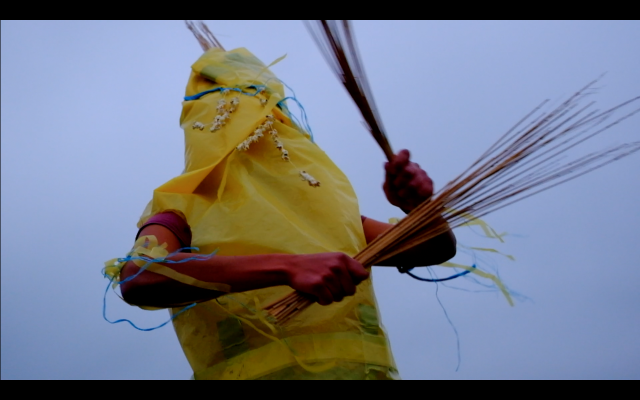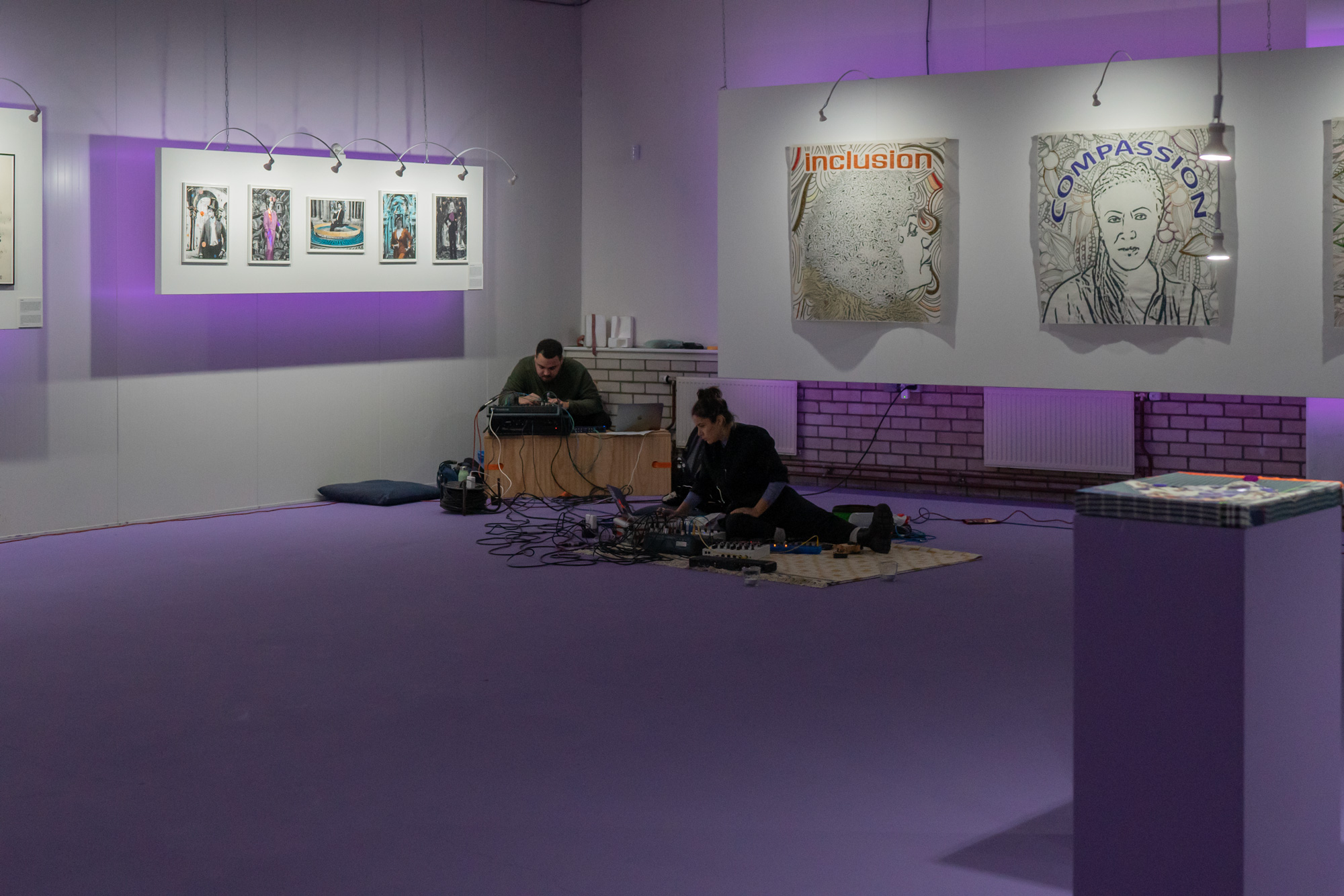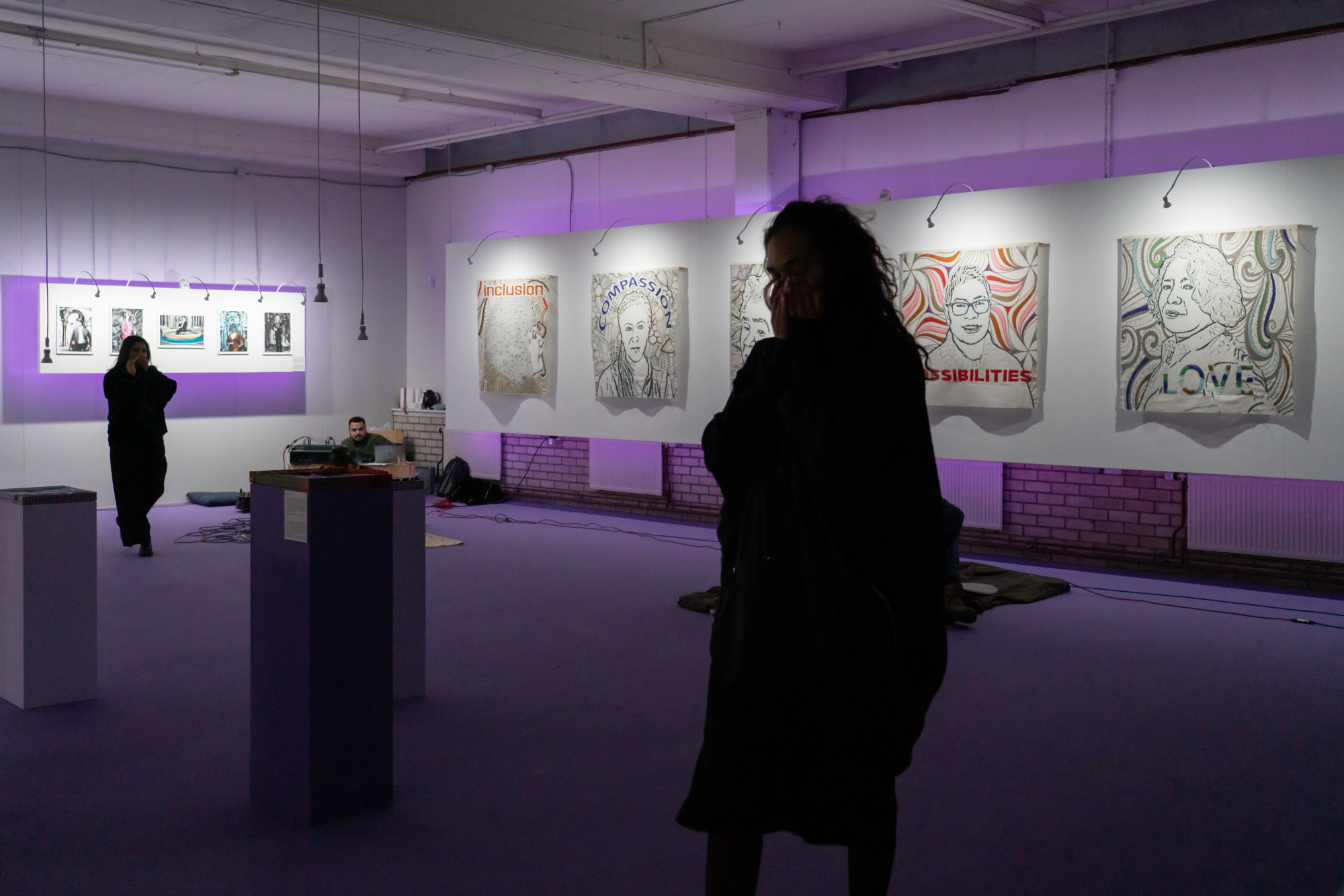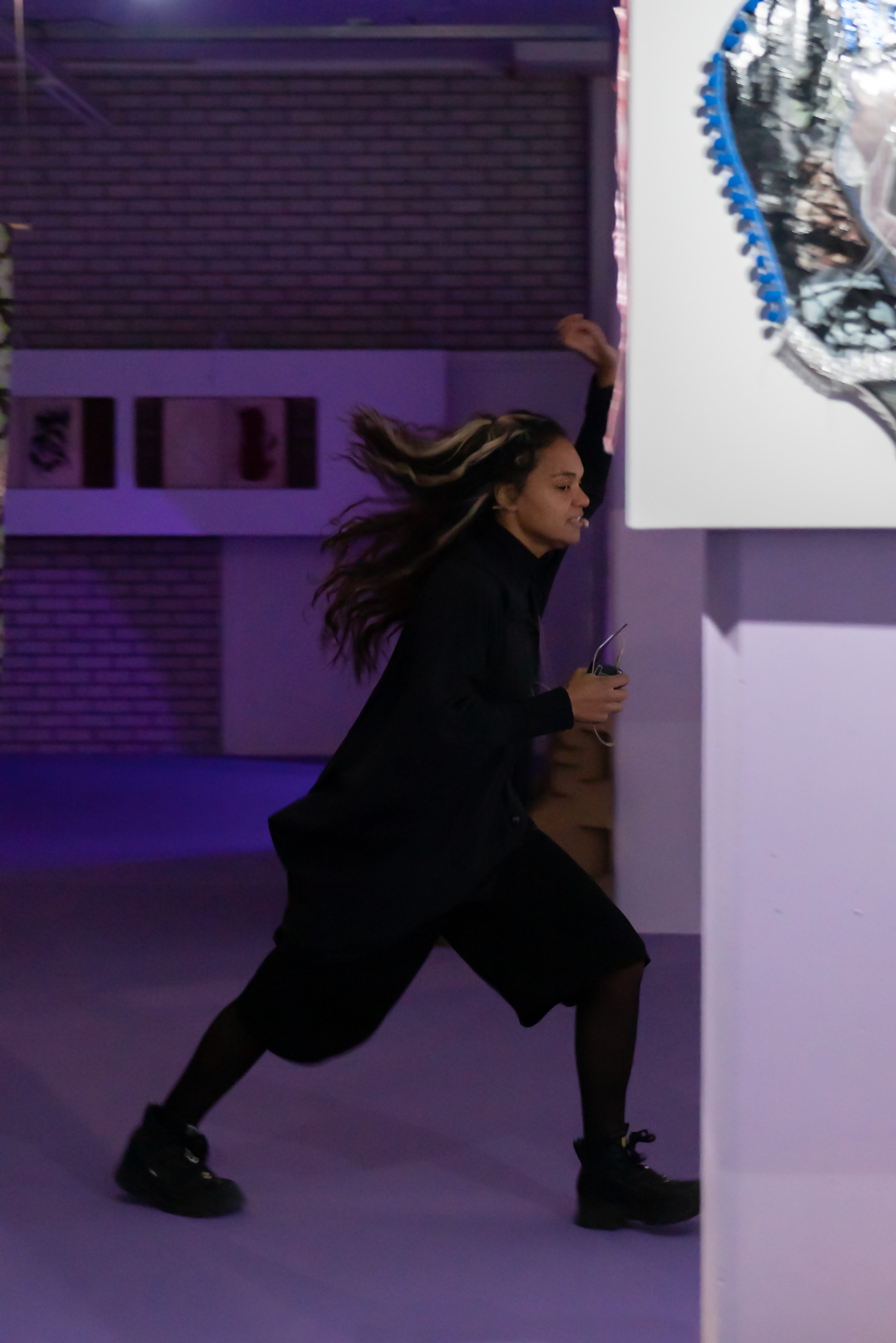Films
Anne Jesuina has made multiple short films while participating in the Ecologies of Transformation programme at the Sandberg Institute.
Sentence (2021)
Film. Anne Jesuina. Sentence.(2021)
A one minute 3D animation about penal colony at the end of the world, where a deity punished white men for their extractive behaviors.
Uma Oração para a Liminalidade (2022)
Trans: A Prayer to Liminality
 Still from A Prayer to Liminality (2022).
Still from A Prayer to Liminality (2022).What does it mean to decolonize? This film seeks to re-center the body as a site of knowledge, spirituality and trust in the midst of the workings white ‘supremacy’ culture. It draws parallels between the human made patterns in the soil and the imposed identities on black and brown and female bodies in a neo-colonial capitalist patriarchal system. It’s an investigation of the gaze of modernity and the suppressing ways in which it makes things seen and valuable, annihilating others
Rouwende (id)entiteiten. (Of: de erfenis van de Rebellie van bacon. (2023)
Trans: Grieving (id) entity (or: the heritage of the Bacon Rebellion.)
Experpt from: Grieving (id) entity (or: the heritage of the Bacon Rebellion) (2023).
A short experimental documentary about a white man that realizes the construction that is his whiteness. The film tells the story of how in 1676, after the Bacon Rebellion, in the British American Colony, Virginia, white and black identities were institutionalized as a response to the revolting European and African workers. The aim of the intensification and institutionalization of racism was to divide the revolting lower class that the elite needed for the development of the (plantation) economy. The film aims to show how this divide-and-conquer strategy still 'works' by drawing a parallel between the Bacon Rebellion and today's anti-racism protests, climate justice protests, and farmers' protests in the Netherlands. Thereby the film reframes today's dissatisfaction of the farmer protests as a colonial issue. It reminds us that polarization is one of the current system's political strategies to not change. Would it be possible to redirect our energies, not towards each other, but towards our common oppressor, through transracial class solidarity?
Performance
Forthcoming (Not Yet Here, But Always Been There) (2022)
Text originally published on: https://ificantdance.studio/field-of-inquiry/forthcoming-intermediary; and written by
Anik Fournier
“These places of possibility within ourselves are dark, because they are ancient and hidden: they have survived and grown strong through that darkness. Within these deep places, each one of us holds an incredible reserve of creativity and power, of unexamined and unrecorded emotion and feeling. The woman’s place of power within each of us is neither white nor surface: it is dark, it is ancient and it is deep” - Audre Lorde in Uses of the Erotic.
Devika Chotoe with Anne Jesuina and Paula Montecinos
![]()
Image: Anne Jesuina in Not Yet Here, But Always Been There), 2022, performance. Photo: Temra Pavlovic.
 Not Yet Here, But Always Been There), 2022, performance. Photo: Temra Pavlovic.
Not Yet Here, But Always Been There), 2022, performance. Photo: Temra Pavlovic.Within the context of her fellowship at If I Can’t Dance, Anne Jesuina and Devika were invited to intervene into artist patricia kaersenhout’s exhibition The Third Dimension at CBK Zuidoost. The exhibition consists of a selection of beautifully executed series of work, in a range of media and spanning several decades. The show highlight’s kaersenhout’s relentless commitment to retrieving forgotten and erased stories, showing how the bodies and lives of black women have been rendered invisible, or conversely, eroticised, in official histories and representations. Kaersenhout’s work reassembles existing images, materials and narratives, stitching and puzzling them into new imaginaries and narratives that reveal how history is malleable; it can be reformalized and rewritten so as to revisit the past in order to reconfigure understandings of the present.

Not Yet Here, But Always Been There), 2022, performance. Photo: Temra Pavlovic.
In the exhibition space of The Third Dimension, the intervention, Forthcoming (Not Yet Here, But Always Been There), moved these charged questions to the site of the body, where histories of colonialism and slavery remain in the form of embodied archives within diasporic communities. With her background in dance, choreography and writing, Devika collaborated with performance artist Anne Jesuina and choreographer and sound artist Paula Montecinos to create a space where their own stories, struggles and desires could be shared. For this, they darkened the exhibition space so that the images and narratives already present in kaersenhout’s exhibition became ghostly figures that conversed with the stories and soundscape of the performing bodies; bodies that carry ancestral histories directly tied to colonialism and migrant labour.
Interview
Soundscape

Not Yet Here, But Always Been There), 2022, performance. Photo: Temra Pavlovic.
Grief and Desire NETWORK
“Rouwen doe je niet alleen” - Nana Efua, Winti Priesteres
Trans: One does not grief alone”
“Every move things” - Bayo Akomolafe
“Grief is to big for one body” - Zien Celeste

In the face of white supremacy culture and all off the ongoing colonial violences against black and brown people, and every other being that does not fit the white supremacist ‘standard’ such as more-than-human animals, forrest bodies, waterbodies and mountains, embracing grief as a communal practice is an act of rebellion, resilience and healing transformation. By feeling into our embodied experiences of oppression and oppressing, we can change toxic into supportive behavior toxic relations into supportive relations, and work towards a culture where the many worlds that are possible can coexist.
//Linneage
The Grief and Desire NETWORK emerged in response to Joy Mariamma Smith, an artist, activist, and teacher of the Somatic Integration and Liminal Objectives class, a core component of the Master Ecologies of Transformation program at the Sandberg Institute (2021-2023). Joy inspired us to create a practice with a real-world impact to take into the world after the MA. I’m forever grateful for this invitation. This practice was born as a way to foster collective practices, breaking through societal (behavioral) forces that pathologize, gaslight, numb, and isolate and to make way for dreaming up concrete steps for action that are in service of collective healing and (transformative) justice.
It’s not ‘I’ who created this exercize. It is the ensemble of all my life experiences, the ancestral linneages that live in my blood and spirit combined with what i learned from other people’s lived realities, dedication, work and wisdom. In this case this wisdom flows from theAfrican and European continents informing each other. People and practices i wish to name and thank specifically are:
*My Brazilian grandmother, Jesuina, daughter of (probably an West-African enslaved woman and the son of the plantation owner, who survived so much and who healed many people with her prayers
* All the indigenous peoples and ancestors that understand that movement and collective ritual heals. For example the Daagba located north of the convergence of Ghana, Burkina Faso and Côte d'Ivoire, The Yoruba people mainly inhabiting parts of Benin, Togo and Nigeria. Including the Celtic ancestors who had an animistc worldview and understood the importance of ritual.
* Camille Barton and their helpful GEN Grieftoolkit which helped me realize the importance of griefwork. And that gave me the courage to put together and do this work with myself and with others. Also Camille’s first book will be out soon. I highly recommend checking out: Tending Grief: Embodied Rituals for Holding Our Sorrow and Growing Cultures of Care in Community”.
*Malkia Devich-Cyril and their vision of collective griefwork as realm for personal healing and political strategy
* Gineke Sietsma who taught me the importance of critical self-assesment and working the muscles of self-love (in order to be emotionally equiped for change).
* Adrienne Marree Brown and the Emergent Strategy way of thinking about change.
With elements of:
Neurolinguistic Programming
Ration Emotive Therapy
Cognitive Behavioral Therapy
IMPORANT: i am very critical of the methods that stem from western psychology in the sense that i reject the individualistic mindset that western humanism and psychology have always promoted. And acknowledge the atrocities that the individualistic mindset has enabled and still enables. At the same time i deeply believe that, when offered in combination with a politicezed somatic view, a scientific understanding of the brain and some tools that these modalities offer are incrediblye tools for self-inquiry and transforming the thought and behavioral patterns that this society has programmed into us and that rule our unconscious which rules 98% of our behavior. I believe that in other to learn new behaviors and habits we need to also learn how to lovingly and critically engage with our thinking and emotional patterns as to deeply transform the pathways that are inscribed in our brains and that govern how we think, feel and act.
The Work
In this immersive workshop, participants embark on a profound exploration of grief, understanding it not as a solitary endeavor but as a collective ritual of healing and transformation. By delving into the interconnected nature of our struggles, we acknowledge the ways in which our own embodiments might unwittingly comply with systems of oppression. Through a series of dialogues and embodied movements, we confront the voids left by missed opportunities for support and solidarity, paving the way for a deeper understanding of our shared struggles and aspirations.
This exercise enables a shift from pathologized loss to collective grieving and dreaming, ultimately addressing the root issue of separation perpetuated by white supremacy culture. Imagining and grieving what has been missing can reveal strategies for change and deepen awareness of the common roots of various forms of oppression. This exercise helps participants recognize the source of their troubles and empowers them to envision and materialize a different way of relating to themselves, their community and the wider world.
The Power of Collective Movement
Through dance and shared expression, we breathe life into the unfulfilled yearnings of the past and reimagine a world where our interconnectedness transcends the boundaries imposed by a divisive culture. Each step, each gesture becomes a testament to the power of collective movement, underscoring the intricate web of relationships that bind us together. By acknowledging our collective grief, we begin to unravel the complexities of our shared human experience, paving the way for healing and reconciliation.
Principle Addressed: Separation
The primary principle this exercise addresses is "separation." It seeks to dissolve the artificial boundaries between groups normalized as 'opposites,' enabling them to grieve together and acknowledge the interdependence of their oppressions. This practice underscores the relational aspects of their identities and experiences. Grief can directs us towards what we most care about, and what we long for. Keeping our grief hidden and isolated perpetuates the myth that separation is natural, a white-supremacist belief that must be challenged.
A Vision of Embodied Social Justice
At the heart of this exercise lies a vision of Embodied Social Justice that transcends the confines of polarizing identities. By engaging in this communal practice, we envision a future where the lines that separate us blur, and our collective grief becomes a catalyst for meaningful change. It is through this process of shared mourning and dreaming that we cultivate a sense of unity, forging paths toward a world where multiple narratives converge and coalesce.
An ocean refuses no river - Ganavya
Take a step into the transformative realm of collective griefing and embodied social justice. Embrace the power of shared experiences, and together, let us navigate the intricate landscapes of our past, present, and collective future. Join us in this powerful exercise and become an active node of change in the movement towards a world in which many worlds are possible.
This workshop can be adjusted and done in so many different contexts’, communities and places! Anne Jesuina has (co-)facilitated the workshop on Keti Koti 2023 Groningen, Landjuweel 2023 and other festivals. If you are curious what this workshop can look like for you, in your community, it would be an honor to receive a message from you!
Participant Response
“Anne took me to a world of hope and healing in a workshop on the transmission of intergenerational patterns. As a workshop leader, she stood in the midst of the group and provided the safety necessary for us to function as a group. It was very worthwhile, and I look forward to the next gathering under her guidance!” - Charlotte Wekker:
Trainer, coach, and instructor in complex innovations within the social domain. Researcher and consultant in the field of equal opportunities. Trainer in transcultural work and the "Beschermjassen" (Protection Coats) approach.
IMPORTANT: i, Anne Jesuina, am not NOT a trauma therapist. This workshop is not therapy, but it can be therapeutic. I create a brave and safer space by asking participants to share only what they are comfortable with, and I provide a structured approach for practicing collective grief responsibly. I am in training to become a coach focusing on emotional understanding and resilience, which influences the workshop's structure.
Anne Jesuina
